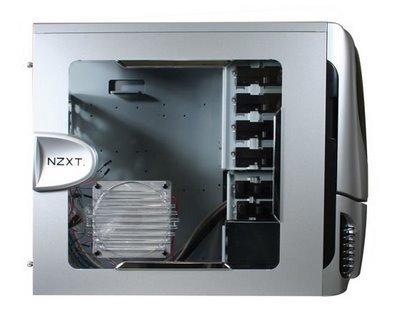
NZXT was founded in 2004 as a company that sells cases especially designed for gamers. Many people want to build their DIY computers using Alienware cases, I admit it, I do too. The Apollo is as Alienware-esque you're go to get from a manufacturer that's not Alienware. Even thought NZXT is a new kid on the block, it designed kick-ass cases such as the Lexa and the Nemesis. Apollo is exception. Retailing around $69.99 USD, it pretty cheap, everything consider. The black part of the case near the top of the bezel is actually smoked acrylic, allowing LEDs to shine through, neat eh? The front I/O panel is on the right side and has two USB ports, a Firewire port, and audio jacks. The shiny piece of plastic right under the door is the power button (the reset button is behind the door). The black line between the power button and the smoked acrylic, is actually a hard drive activity LED, which is helpful. The case also features 5 external 5.25" drive bays, 1 external 3.5" drive bay and 4 internal 3.5" drive bays. It is cooled by two 120mm blue LED fans (actally they're a teal color), one located on the side and one in the back. The front intake fan in optional. On either side of the chrome slots on the bezel are two blue LEDs, click
here for a hi-res picture. The Apollo case's bezel is kept closed by magnets. The case is made from SECC steel, which makes the case weigh a hefty 7.2 kg, without anything inside it. Overall the case is very study on the outside.

Now for the inside. The Apollo comes with a standard full side window and a 120mm fan in it. Opening up the case was easy, just unscrew the two thumbscrews, and your in. The Apollo case is almost totally tooless, you can throw away your screwdriver once you installed your motherboard and PSU. Unlike some other vendors, NZXT's "tooless" design
is actually tooless. Instead of clipping some plastic pieces to each end of your CD-ROM drive, you simply have to slide it in and move the black piece over until it clicks into one of the holes. Then you push down and it's good to go. This is an awesome way to secure you CD-ROM drives, but I don't see often enough. The only downside is the black clips are a bit large, but compared to the ugly tan-colored ones, these blacks ones are awesome. Motherboard installation was easy with the included manual.

Installing a graphics card or a sound card is unbelievably easy, all you need to do, is push one of the black clips up (above). Once you do that, you can remove the metal guard and install the card. Once the card is in place, you snap this plastic piece back down to securely keep the card in place. Simple as that. Conclusion: the Apollo is everything that a good gaming case should be. The only knock against the case is that it does include a front fan, but for $69.99 USD, who cares? Anyway, cooling performance didn't suffer so I'm not complaining. The Apollo is currently the gaming case to have, and it even takes over the spot of the former case champion, the NZXT Lexa ;)
 The International Astronomical Union's 2,500 astronomers (representing 75 countries) gathered to decide the fate of Pluto and the results are in. The International Astronomical Union (IAU) voted to demote Pluto from the ranks of the solar system's now 8 planets. The reason Pluto got demoted is because Pluto no longer fits the newly ratified definition of a planet. The new definition states that a planet is “a celestial body that is in orbit around the sun, has sufficient mass for its self-gravity to overcome rigid body forces so that it assumes a ...nearly round shape, and has cleared the neighborhood around its orbit.” Pluto is disqualified because it does not clear the neighborhood around its orbit since its orbit overlaps with its much larger neighbor Neptune. Instead, Pluto will be classified as a dwarf planet and be classified with the other dwarf planets.
The International Astronomical Union's 2,500 astronomers (representing 75 countries) gathered to decide the fate of Pluto and the results are in. The International Astronomical Union (IAU) voted to demote Pluto from the ranks of the solar system's now 8 planets. The reason Pluto got demoted is because Pluto no longer fits the newly ratified definition of a planet. The new definition states that a planet is “a celestial body that is in orbit around the sun, has sufficient mass for its self-gravity to overcome rigid body forces so that it assumes a ...nearly round shape, and has cleared the neighborhood around its orbit.” Pluto is disqualified because it does not clear the neighborhood around its orbit since its orbit overlaps with its much larger neighbor Neptune. Instead, Pluto will be classified as a dwarf planet and be classified with the other dwarf planets.
















